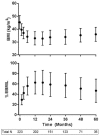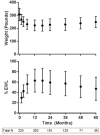Laparoscopic vertical sleeve gastrectomy: A 5-year veterans affairs review
- PMID: 28858079
- PMCID: PMC5585473
- DOI: 10.1097/MD.0000000000007508
Laparoscopic vertical sleeve gastrectomy: A 5-year veterans affairs review
Abstract
The aim of this study was to evaluate the outcomes after laparoscopic sleeve gastrectomy (SG) in a VA population.SG has recently gained popularity as a definitive bariatric surgery procedure. Data are lacking on long-term outcomes, particularly in a Veterans Affairs population.We retrospectively reviewed 223 patients who underwent SG for morbid obesity between January 2009 and June 2014. Data on length of stay, complications, interval weight loss, comorbidities, and number of therapies preoperatively and at long-term follow-up were collected.There were 164 males and 59 females who underwent SG. The mean body mass index was 45.4 kg/m. Mean excess weight loss at 1 year was 62.9%, and 47.0% at 5 years. Weight loss continued until 12 to 18 months, when there was a nadir in weight loss (P < .001). There were 4 deaths and 4 staple-line leaks, with 3 deaths related to late cardiac events. One early death occurred in a very high-risk patient. All staple-line leaks were managed nonoperatively. Of the 223 patients, 193 had hypertension, 137 diabetes, 158 hyperlipidemia, 119 obstructive sleep apnea (OSA), and 125 had gastroesophageal reflux disease. Preoperatively, patients were on a mean of 1.9 antihypertensive and 0.9 hyperlipidemic, anti-reflux and oral hypoglycemic agents. Fifty percent of patients with diabetes were on insulin and 68% with OSA used continuous positive airway pressure/bilevel positive airway pressure (CPAP/BiPAP). We found significant absolute reductions in mean antihypertensive medications (-0.8), hyperlipidemic agents (-0.4), antireflux agents (-0.4), oral hypoglycemics (-0.6), insulin use (-25%), and use of CPAP/BiPAP (-55%) (all P < .001).Laparoscopic sleeve gastrectomy is a safe and effective bariatric surgery procedure, resulting in significant early weight loss up to 18 months and long-term improvement in all major obesity-related comorbid conditions.
Conflict of interest statement
The authors report no conflicts of interest.
Figures


Similar articles
-
Laparoscopic Sleeve Gastrectomy for Morbid Obesity at a Veterans Affairs Medical Center.J Laparoendosc Adv Surg Tech A. 2018 Jun;28(6):650-655. doi: 10.1089/lap.2018.0002. Epub 2018 Mar 28. J Laparoendosc Adv Surg Tech A. 2018. PMID: 29589988
-
Outcomes of Laparoscopic Sleeve Gastrectomy and Roux-en-Y Gastric Bypass in Patients Older than 60.Obes Surg. 2015 Dec;25(12):2251-6. doi: 10.1007/s11695-015-1712-9. Obes Surg. 2015. PMID: 26001882
-
Long-term results after laparoscopic sleeve gastrectomy in a large monocentric series.Surg Obes Relat Dis. 2016 May;12(4):757-762. doi: 10.1016/j.soard.2015.09.028. Epub 2015 Oct 1. Surg Obes Relat Dis. 2016. PMID: 26806727
-
Review of long-term weight loss results after laparoscopic sleeve gastrectomy.Surg Obes Relat Dis. 2014 Jan-Feb;10(1):177-83. doi: 10.1016/j.soard.2013.11.007. Epub 2013 Nov 21. Surg Obes Relat Dis. 2014. PMID: 24507083 Review.
-
Comparative analysis of weight loss and resolution of comorbidities between laparoscopic sleeve gastrectomy and Roux-en-Y gastric bypass: A systematic review and meta-analysis based on 18 studies.Int J Surg. 2020 Apr;76:101-110. doi: 10.1016/j.ijsu.2020.02.035. Epub 2020 Mar 6. Int J Surg. 2020. PMID: 32151750
Cited by
-
Insulin Dose Adjustment Following Bariatric Surgery, a Review of Available Literature.J Diabetes Sci Technol. 2022 Nov;16(6):1560-1566. doi: 10.1177/19322968211028886. Epub 2021 Jul 1. J Diabetes Sci Technol. 2022. PMID: 34210197 Free PMC article. Review.
-
Meta-analysis of Long-term De Novo Acid Reflux-Related Outcomes Following Sleeve Gastrectomy: Evidence Against the Need for Routine Postoperative Endoscopic Surveillance.Curr Obes Rep. 2023 Sep;12(3):395-405. doi: 10.1007/s13679-023-00521-4. Epub 2023 Aug 3. Curr Obes Rep. 2023. PMID: 37535236 Review.
-
Changes in Antihypertensive Medication Following Bariatric Surgery.Obes Surg. 2022 Apr;32(4):1312-1324. doi: 10.1007/s11695-022-05893-5. Epub 2022 Jan 26. Obes Surg. 2022. PMID: 35083703 Free PMC article. Review.
-
Five-Year Outcomes with Stand-alone Primary Sleeve Gastrectomy.Obes Surg. 2019 May;29(5):1607-1613. doi: 10.1007/s11695-019-03756-0. Obes Surg. 2019. PMID: 30719651
-
Do bariatric patient's in rural areas achieve comparative weight loss as national average? single center experience in appalachia west virginia.Surg Endosc. 2022 Nov;36(11):8515-8519. doi: 10.1007/s00464-022-09541-y. Epub 2022 Aug 30. Surg Endosc. 2022. PMID: 36042042
References
-
- WHO Media Centre: obesity and overweight. Available at: http://www.who.int/mediacentre/factsheets/fs311/en/index.html 2014. Accessed March, 2017.
-
- National Institutes of Health (NIH), National Heart, Lung, and Blood Institute (NHLBI) Clinical guidelines on the identification, evaluation, and treatment of overweight and obesity in adults. Washington, DC: U.S. DHHS, Public Health Service (PHS) 1998.
-
- Allison DB, Fontaine KR, Manson JE, et al. VanItallie TB annual deaths attributable to obesity in the United States. JAMA 1999;282:1530–8. - PubMed
-
- U.S. Centers for Disease Control and Prevention. Behavioral Risk Factor Surveillance System: Prevalence and Trends Data–Overweight and Obesity, U.S. Obesity Trends, Trends by State; Available at: https://www.cdc.gov/brfss/brfssprevalence/index.html. Accessed August, 2016.
-
- U.S. Department of Health and Human Services: The Surgeon General's call to action to prevent and decrease overweight and obesity; Office of Disease Prevention and Health Promotion; Centers for Disease Control and Prevention, National Institutes of Health. Rockville, MD; 2001.
MeSH terms
LinkOut - more resources
Full Text Sources
Other Literature Sources
Medical

